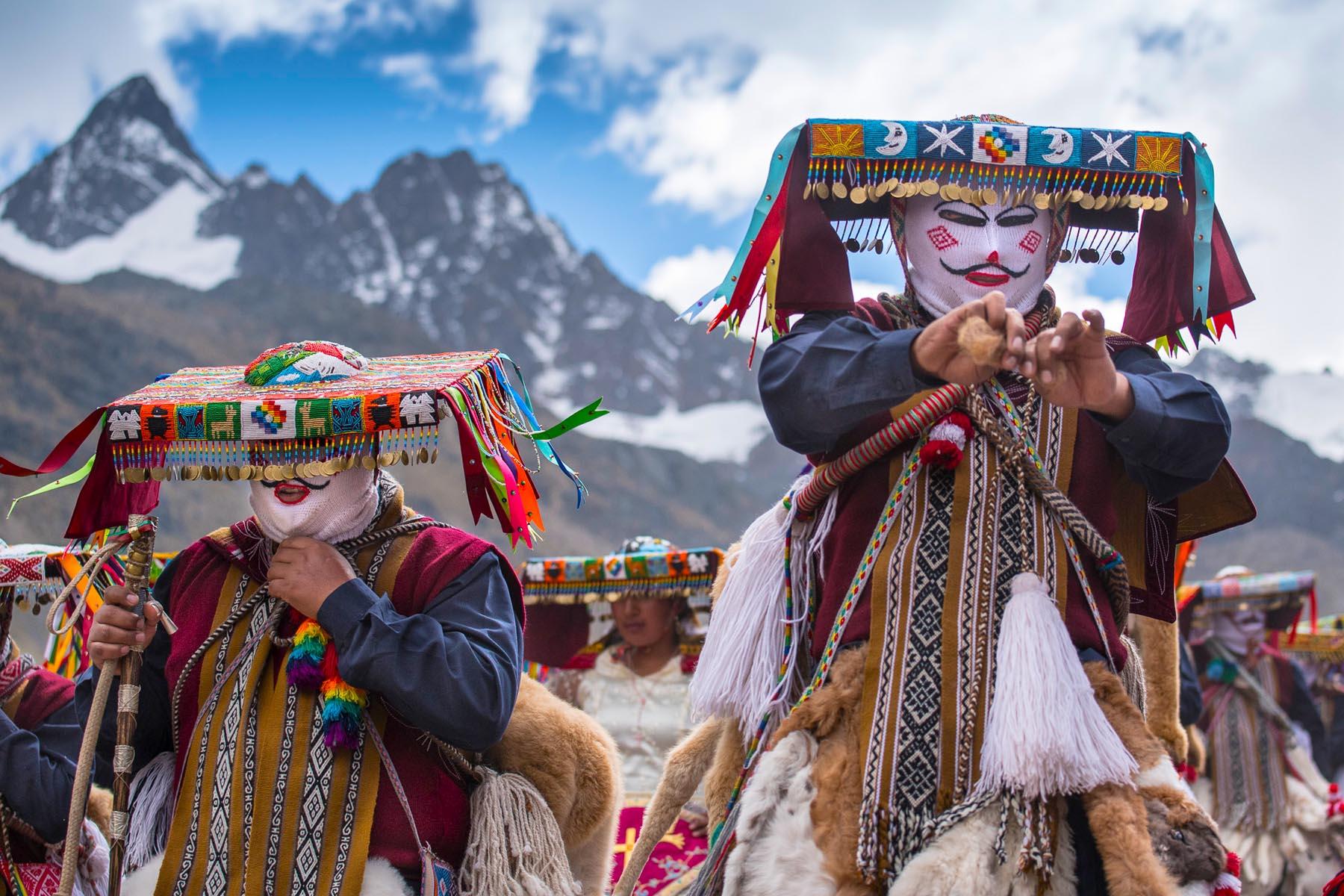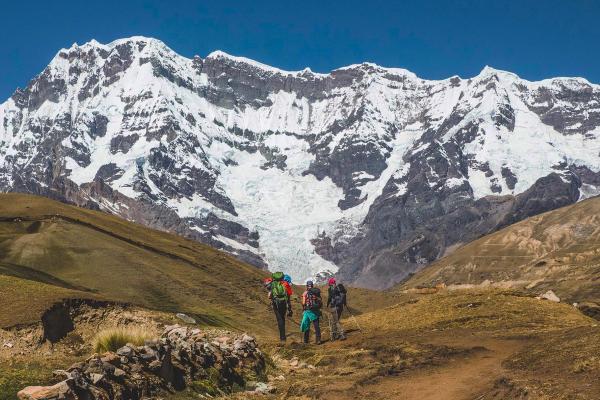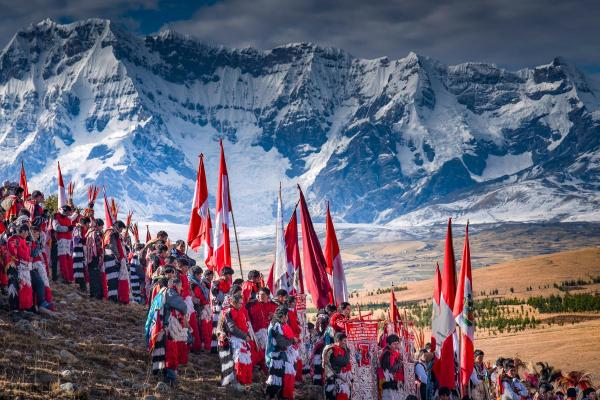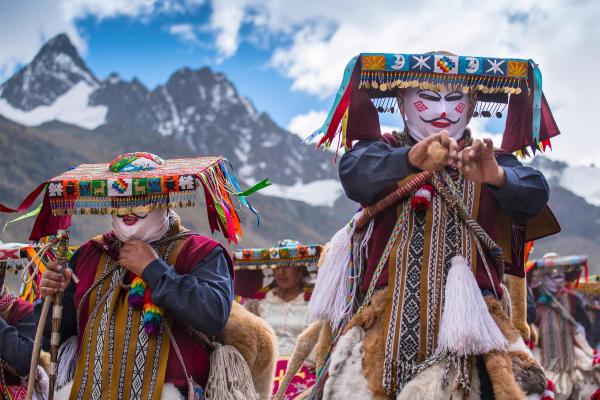Qoyllorit'y Feast
$0.00/From
The festival of Qoyllorit'i or Quyllur Rit'i, celebrated annually in honor of the Lord of Qoyllorit'i, is one of the largest religious activities that takes place in the southern highlands of Peru, with the active participation of many devotees. They call themselves nations, coming from different towns and cities.This festivity takes place in the foothills of the Ausangate mountain at 5362 masl, this in the town of Sinakara in the province of Quispicanchi in the department of Cusco. This festival and the sanctuary of the Qoyllorit'i were declared cultural patrimony of the nation on August 10, 2004. Subsequently, on November 27, 2011, Unesco registered the "Pilgrimage to the Sanctuary of the Lord of Qoyllorit'i" as a member of the Representative List of the Intangible Cultural Heritage of Humanity.Qoyllority is considered the most important religious Andean festivity. It is a living example of the religious syncretism between the catholic religion and the Andean religiosity; This festivity consists of a mixture of "adorations, rituals" that take place in the Ausangate mountain (after a pilgrimage of 8 kilometers to more than 4200 meters). Qoyllority, comes from two Quechua voices (Qoyllor - Star and Rity - Snow), this is a festival that is inherited from the Inca culture, at that time this festivity was dedicated to the Pleiades that play an important role for agriculture and is intimately linked to the winter solstice.Qoylloriti is the center, it is the place where a natural, very energetic phenomenon of white, purifying energy is generated. Because in that time, which is Qoylloriti, the Earth is located in a position with respect to the Sun, by the development of the translation of the Earth, of its location. At that time there is a phenomenon that comes from the Sun to the Earth and is located, precisely, in its position in Qoylloriti, which causes this energy to come changed through water, that is, this energy is deposited in the rhythm, in Snow. This energy comes through the Cosmos, it comes through the dust of the stars, as our grandparents call the inhabitants. The dust of the stars is the energy that will give us the new life, the new light, comes to the snow and through it to the water. That is why ancestrally the ukukus (bear-man) carry the snow and collect that dust from the stars, of revitalizing energy, of light, of life, it is collected and taken to clean the place, first the house, the body of one and everything it contains, it is cleaned, it is changed, it is projected. Every year thousands of people from the Cusco region and surroundings make this pilgrimage to the shrine of the Lord of Qoyllority located at 4250 meters. Last year around 80,000 people visited Qoyllority.
Quick Itinerary:
- Day 01 (June 10th): Cusco - Mahuayani
- Day 02 (June 11th): Mahuayani – Sanctuary of Qoylloritti
- Day 03 (June 12th): Santuary of Qoylloriti
- Day 04 (June 13th): Sanctuary of Qoylloritti – Yanacocha – Night Pilgrimage to Tayancani
- Day 05 (June 14th): Tayancani - Cusco
PILGRIMAGE TO THE LORD OF QOYLLUR RIT'I:
The pilgrimage to the sanctuary of the Lord of Qoyllur Rit'i takes place every year in the month of May or June, the date is not exact due to the Andean calendar, but it is between these two months. The festival is one of the Catholic festivities fused with the Andean, located in the place of Sinacara that congregates an endless number of pilgrims devoted to the miraculous image, entire populations of southern Peru, also called Nations that are organizations of musicians , dancers and devotees, come from different places of the provinces of Cusco. The festival begins on the day of the Holy Trinity, when more than 10,000 pilgrims ascend to the limit of perpetual snow. It reaches minimum temperatures of -4 ° C. The path is accompanied by a procession, fireworks and the symbolic market of Alacitas (fair of miniature crafts). After five hours of walking you will arrive at the sanctuary of Qoyllur Rit'i, you will have to make the greeting of honor to the image of miraculous Christ in the afternoon. All the comparsas make their official entrance through Nations. almost 200 comparsas giving their official greeting that lasts almost all night, accompany different dancers who symbolize various mythical characters. The "pablitos" or "ucucos" who are the intermediaries between the Lord of Qoylloriti and the men ,are those who maintain discipline during the liturgical acts and dressed as bear (black suit made of thick cloth and wool, with a chullo) that they make order and peace that they also call the soldiers of the Lord.
History:
The ritual, associated with the fertility of the land and the worship of the Apus (hills, tutelary gods), is part of one of the largest Native American festivals in America. The main ceremony takes place at the foot of the snow-capped Ausangate, the ritual consists of a pilgrimage of shepherds, merchants and onlookers who meet at the sanctuary of Sinakara in the village of Mawayany, at 4600 meters above sea level. According to the belief, the Child Jesus, disguised as a shepherd, appeared to an indigenous child, Marianito Mayta, and both became friends. When the parents found them dressed in rich attire, they notified the parish priest of the place, Pedro de Landa, who tried to capture him but without success, because in the place of the Child a stone appeared. Marianito died immediately and the image of the Lord of Qoyllur Rit'i was painted on the rock.
The "Pucllanapata":
In Pucllanapata (place of the game), located a few meters from the chapel, the faithful participate in the "Fair of Fantasies", which consists, in the style of the Alasitas in Puno, in buying objects, stones that represent material goods desired by the settlers. There they perform marriages, delivery of property titles with notaries, academic degrees and others. On the third day of the pilgrimage the procession of the Blessed Sacrament takes place and on the fourth day the entrance to the temple of the "Paucartambo Nation" is completed, with which the procession of the Lord of Qoyllurit'i and the Sorrowful Virgin begins. After the procession, the "Alabado" is performed, a ritual in which the faithful offer their hopes, strength and faith to the Lord; in the evening hours the vigil is performed to the Lord of Qoyllorit'i. It is on the fifth day that dance troupes come to the skirts of Sinakara to wait for the little people and talk about their villages. The opportunity is propitious to see multicolored rows that move to the temple for the central mass. Two groups, the Qhapaq Qollas of Paucartambo and Quispicanchi are the ones who sing for the Lord of Qoyllurit`i. At the end, in this place, they will receive the blessing with holy water.
The "Intilloqsimuy":
After several kilometers of nocturnal walk, the walkers arrive at the so-called Intilloqsimuy, located in the eastern chain, where they will wait for the sunrise. The day begins with the beat of the Quechua melodies. When the sun rises, the pilgrims receive on their knees the first solar rays with prayers as a clear ancestral evocation, then all descend in a row holding hands and arrive at the chapel of Tayankani, where they perform their last prayers. In Ocongate, the last procession and the blessing of both images in the direction of the four cardinal points, where everyone says goodbye with the hope of seeing each other next year.
This is how the celebration is lived
Today, the festival is an example of how climate change affects us more than our day to day. Here the mountains are considered sacred and known as "apus" (spirits of the mountain or gods). The tradition is lived by each province represented at the festival. How? Each one must sculpt heavy pieces of ice from the glacier - this symbolizes water and life - to return to their communities.
- And how does climate change affect? What happens is that the glacier is getting smaller and you can not take the ice anymore. If the glaciers continue to melt because of climate change, perhaps in the not too distant future this festival will not be able to be celebrated.
This tradition is not only Andean
It is a mixture of native and Catholic culture. The reappearance of the Pleiades constellation in the night sky is celebrated, marking the beginning of the new Andean year and the harvest season. On the Catholic side, legend has it that in 1780, a white-skinned boy appeared to a young shepherd who lived in the mountains. But when suspicious villagers came to him, it became stone. The belief is that child was Jesus.
- It was not always a happy feast... There was tension between the villagers and the Spaniards from the 16th century until the end of the colony. All because Spain tried to nullify the indigenous language and its culture. But at the festival, both cultures eventually became intertwined. The group of guardians of the Qoyllus Riti tradition, known as "pablitos" in Spanish ("ukukos" in Quechua) was in charge of preserve the festivity. The pilgrimage is a test of resistance. It takes days to arrive, stopping in each village on the route to pray, dance and sing. Arriving by truck can take six days. Here you will learn to "chacchar coca" that means eat coca leaves and enjoy the music heard to advance without rest. Worshipers disembark in Mahauyani.
Interesting Information:
- Inti Raymi in Cusco
- Peruvian Festival
- City Tour in Cusco
- Cheap Rainbow Mountain
Tour Plan
Day 1: Cusco - Mahuayani
We leave the city of Cusco by private bus, and drive along the Cusco - Puerto Maldonado highway in the direction of Tinki (3800 masl) and Mahuayani, where we will arrive by approximately 3:00 pm. On the way we will stop at Urcos, where we will visit a beautiful lake with the same name, which then pass to Cattca, an agriculture and cattle ranch of the community where we appreciate spectacular views of the region, following Ocongate, capital of the district of the same name, Tinqui, being the starting point for most of the tours in the Ausangate area, and Mahuayani last (4600 masl) after an approximate drive of 7h. In the afternoon, we take the opportunity to visit the local market, before having dinner at our nearby camp.
Day 2: Mahuayani - Sanctuary of Qoylloritti
We will wake up very early and after our delicious breakfast, we will start our walk to the Qoylloritti Sanctuary, located in an impressive place, surrounded by snow-capped mountains. That little by little, although an uphill walk track along which we will find 14 crosses that are venerated on the way, the last one is already in the Sanctuary. Upon arrival, we will be housed in the camp and enjoy free time in the afternoon. The visualization of the activities in the Sanctuary is impressive, as well as the number of pilgrims who attend this festival year after year. In the afternoon, we can attend the Mass in the Sanctuary, there are two ceremonies, at 06.00 or 08.00 pm Dinner and camp in the Sanctuary
Day 3: Sanctuary of Qoylloritti
This day is spent in its totality in the Sanctuary, as a result of the activities of the pilgrims. We attended the "Alacitas" morning markets. This is a very curious screen in which one buys miniature products, such as trucks, houses, cattle, university degrees and others, with the money that is only valid during the festivity of Qoyllur Ritti, according to the wishes of a real one. The legend says that whatever you achieve in this game will become reality thanks to the power of the Lord of the Qoylloritty. The soul mass in the atrium of the sanctuary (10.00 am) is the next event followed by the "pablitos" mass at 12.00. The afternoon is reserved for other activities, for all those who want to join them: the procession of the Lord of the Tayancani and the Virgin, various dance performances, mass in the Sanctuary at 06.00 and singing to the Lord at 07:00 . At night, after dinner, we enjoyed the spectacular "The burning of castles", in which the construction of wood with fireworks are burned, followed by "El baile del niño" or "The dance of the kid". Afterwards, the pilgrims climb the snow-covered mountain and the glaciers to bring down the crosses to the Sanctuary.
Day 4: anctuary of Qoylloritti - Yanacocha - Night Pilgrimage to Tayancani
On this day, we will participate in the most famous pilgrimage in Cusco.At 10:00 a.m and at noon. we will attend the Blessing Mass leaving the famous 24 hours procession, together with the rest of pilgrims. The procession leaves from the Sanctuary and runs through Calvario Machucruz, the lagoons in Kumukasa and Alqamarina sectors, until reaching Yanacocha, where we arrive at around 06.00 pm. Finally, we will spend the night and sleep for 3-4 hours until the start of the walk to Tayancani.
Day 5: Tayancani - Cusco
After an early awakening,we will pack our bags and prepare for the pilgrimage. We hope and attend the blessing Mass, Lunch and descent to the village of Mahuayani. In the afternoon, on board our private transport back to Cusco (5h), where we hope to arrive around 6:00 p.m.
Included & Excluded
Details about services not included and details not included in our packages, if you have any questions please contact us.
- Pre -Briefing (a day before your tour)
- Private transport to Mahuayani (starting point of the pilgrimage)
- Tinki visitor fee
- Campsite fees
- Personal tents: 2 people in each 4-people-capacity tent, to allow for higher comfort and a safe keeping of backpacks. . The tents employed for treks around the Ausangate area are 4-season Eureka K2XT, highly maintained to ensure an excellent performance in field
- One inflatable sleeping pad per person
- One sleeping bag per person: our sleeping bags are -18ºC-comfort (0ºF), mummy form and include a sleeping liner. They are cleaned after every use and have a maximum usage of 30 trips
- One pillow per person
- Dining tent with tables and chairs
- Kitchen tent
- Toilet tent with biodegradable toilet facilities
- English speaking professional tourist guide (2 guides for groups of over 8 people)
- Chef and cooking equipment
- Horses (to carry tents, food and cooking equipment)
- Horses to carry personal gear up to a maximum of 9kg per person (including sleeping pad and sleeping bag)
- 1 emergency horse every 6 persons
- Meals (04B, 05L, 04D + daily morning snack + daily tea service except last day). Vegetarian or special menus are available at no extra cost
- One textile snack bag per person, to avoid the usage of plastic bags that contaminate our environment
- Filtered boiled water from lunch time on 1st day onwards
- Bio-degradable personal hand soaps
- Bio-degradable dishwashing detergents used by our kitchen staff
- Others: hot water every morning and evening for washing purposes / boiled water to fill in your water bottle every morning and night, and at lunch time if requested with enough time ahead
- First-aid kit including emergency oxygen bottle
- Private transport from Ocongate to Cusco, including transfer to your hotel in Cusco 24-h guest service: please ask for the emergency number available during your time of visit
- Breakfast on the first day and dinner on the last day
- Tips
- Some extra expenses not mentioned
REMEMBER TO CARRY:
- A backpack with a change of clothes for the whole period of the trek
- Rain jacket or poncho (plastic ponchos can be purchased in Cusco)
- Strong footwear, ideally trekking or sport shoes
- Flashlight and batteries
- Camera, films and batteries (batteries consume more quickly under cold conditions)
- Toilet paper
- Snack: biscuits, energy bats, chocolate etc.
- Non-disposable canteen and sterilizing tablets (ie. Micropur)
- Cash in soles
- Optional: walking sticks or poles
- Daily backpack
- Sunscreen
- Hat
- Warm Clothes
- Personal medication











